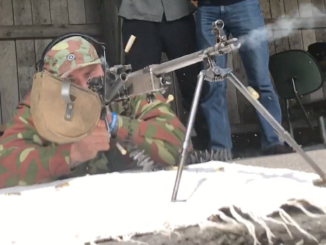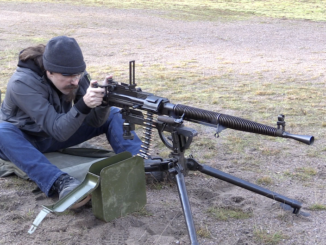In response to a Finnish military need for a machine gun better than the old Maxim for aerial and anti-aircraft use, Aimo Lahti developed the L33 machine gun from the basis of the Lahti-Saloranta design. It was recoil operated, with the ubiquitous Lahti accelerator lever, and a quite high rate of fire. Total production was quite small, but several different versions of the gun were made for mounted AA use, aircraft wing mounting, and aerial observer mounts. This example is from the last pattern, the L33/39. Despite its designation, deliveries were not made until after the end of the Continuation War, as the manufacturer (VKT) had many higher priority projects during the fighting. The L33/39 is chambered for the standard Finnish 7.62×54 (53)mm cartridge, and uses a 75-round pan type magazine.
We also take the Lahti L33/39 out at the range to try out. We have the gun on a naval-type cone mount, but it is not secured down to the ground. I was taken rather aback by the really high rate of fire, and the gun rocked back on its mount more than I expected! In addition, it was extremely difficult to load the magazines, as we didn’t have the original loading machine.




“(…)several different versions of the gun were made for mounted AA use, aircraft wing mounting, and aerial observer mounts(…)”
There also existed armoured car version, which was used in Landsverk 182 armoured car https://www.jaegerplatoon.net/ARMOURED_CARS4.htm#Landsverk
With such a high rate of fire, the loose mount, and the relatively small backstop, hope y’all didn’t have to do any roof patching afterwards!
http://airwar.ru/weapon/guns/l33.html claims that these machine gun were nicknamed Mikkihiiri by Finnish soldiers, however reason is given as unknown. Does anyone what is whyabout of said nickname for that weapon?
Should bolt the stand to a sheer of plywood, or perhaps use dog lead tie downs next time
You will need more than just plywood to absorb all that recoil. I was thinking more in terms of railway ties.
That high rate of fire and massive recoil proves that MANPAD Gatlings or chain guns are impractical.
That red shed in the background looks like it contains a running-boar target.
War time production in a poor country with a tiny population (about the same as Ireland, after Dev had trashed its economy)
Yet masses of beautifully executed machining, and a standard of finish (no pun intended) to match an interwar Mauser.
Assuming a very rigid set up, a machine tool can remove up to about a cubic inch of steel, per horse power per minute
Obviously it’s a lot less when set ups become less rigid and finishing cuts are being made
I wonder how many tens of pounds of chips were produced for each gun?
Also, how was the VKT plant being powered?
Finland isn’t blessed with mountains for hydro power, nor with coal mines, and definitely not with oil and gas fields
Which I guess leaves wood or peat fired?
Finland does have hydro power, over 20% is generated that way now; I guess they were importing German coal; and a great deal of the countryside had no electricity supply until the second half of the last century. I was there in 1968 and remember one uncle had a tv powered with car batteries.
Ireland’s population before potato famine (1841): 8.18 million.
Ireland’s population 20 years later: 5.18 million.
Ireland’s population in 1911 (still British): 4.38 million.
Ireland’s population in 1923 (after partition):4.32 million.
Ireland’s population “after DeValera trashed its economy”: 4.29 million.
Credit where it’s due from a Texan descendant of Ireland’s oppressors.
“(…)peat fired?”
I am not sure about 1930s, but currently it is used in some power stations
https://en.wikipedia.org/wiki/List_of_power_stations_in_Finland#Biomass_and_peat
I assume the best way to not overwhelm a bomber gunner with the recoil is to install the gun in an electrically powered turret with a very strong frame. I could be wrong.
it’s about the only way. Attempts at .50 twin gun waist mounts on Army B-24s and Navy PBYs during the war showed that trying it with anything heavier than .30 caliber was a waste of time.
The Navy solution on PT boats was a fully articulated ring mount not unlike that used in WW1 on bombers. The recoil has to be taken up entirely by the mount, or you’re not going to hit anything except a lot of empty sky.
cheers
eon
Would have used that body bar would have helped some , bolted to 1000 lb of concrete ir steel even better.